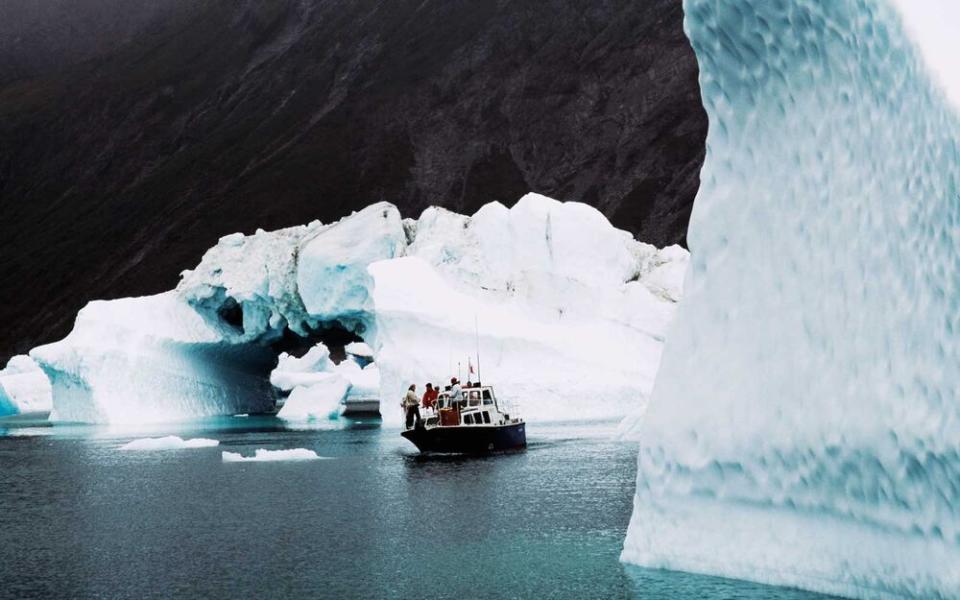Why You Should Visit Greenland in the Summer
For three months out of the year along the fjords of southern Greenland, the frozen landscape thaws, the sea ice retreats and you can see why Erik the Red got away with calling the country at the top of the world “Greenland” – instead of Narnia.
I visited in June, traveling up the Tunulliarfik Fjord with Vintage Air Rally during an arctic expedition, and found fields of wild flowers three feet high covering the hills and idyllic farms in the lowlands growing tomatoes, carrots, lettuces and root vegetables. The whole scene looked to be ripped from an Andrew Wyeth playbook and is almost identical to the Western Fjord region in Iceland, with the exception of the rolling and calving icebergs that are deposited daily into the by the nearby Qooroq Glacier.
But unlike Iceland, there are no tour busses or hordes of visitors, and the hardy few who take the extra flight from Nuuk, Reykjavik, or Copenhagen to experience this lonely part of the world are rewarded with stunning views of brutally beautiful mountains; the idyllic villages of Qassiarsuk, Narsaq, and Nassarsuaq dotting the coastline; and an important slice of history.

While it seems the world is just waking up to Greenland, it has been part of important trade routes since 982, when Erik the Red first settled here. Not that Erik really wanted to come at first.
“Erik was banished from Iceland for three years,” Ole Guldager, the manager of the Narsarsuaq Museum explained. “He had a very fierce temper and killed a couple of slaves. Even though Vikings were very fierce, this was not acceptable behavior so he was asked to leave for three years. If he had stayed everybody had the right to kill him, so he left for his own health.”
Erik sailed West and found the Tunulliarfik Fjord, which he was so taken with he decided to move there permanently.
“After the three years of banishment he was allowed to go back, but he chose to encourage others to come to Greenland,” Guldager explained. “You see, in Greenland he would be king, where as in Iceland he would just be a farmer — so he grabbed the chance to be the father of a nation.”
Today, visitors can fly into the short runway at Narsarsuaq — considered one of the ten most dangerous runways on earth — and visit the Norse ruins at Qassiarsuk (formerly Brattahlid) across the bay. Located at the mouth of the fjord, the modern day farming village surrounds a reproduction of a Viking longhouse, the first church in Greenland, as well as an ancient Inuit turf house. The scene is bucolic — until one imagines what life is like for the people here eight months out of the year.
“The fjord freezes up 10 meters thick and 20 kilometers long during the winter,” Sam Rutherford, owner of the Vintage Air Rally and pilot who has flown into Narsarsuaq several times, said. “It’s quite brutal.”
%image1
But during the summer, the area is a slice of heaven. The weather warms and stabilizes and visitors can hike to the ice sheet just two miles away, mountain bike to glaciers, kayak, sail, and fish in the fjord — all while keeping a look out for whales, polar bears, and seals.
The main hotel in the area is the Narsarsuaq Hotel, which has 92 rooms and stays open all year round. The hotel — as with most places in the arctic, including Iceland — is not cheap. At $250 a night, it is a basic hotel, but the restaurant serves world class food like ocean trout with hollandaise, root vegetables, green beans, and a fresh salad. All produce and meat are from the farms across the fjord or off the fishing boats that set out daily and, considering how far away one is from the rest of the world, surprisingly delicious.
For the more rugged amongst us, the Leif Erikkson Hostel in Qassiarsuk is just down from the ruins and directly below a statue of Erik’s son, Leif, that dominates this end of the fjord. For just $40 a night it is clean, comfortable, and provides guests with mountain bikes and guides.
“The Vikings lived here for 500 years — a very long time,” Guldager said. “It is the same time span from Columbus to the present day — and then they disappeared. Most scientists believe it was due to several things: the environment, lack of trade. And the black plague had coursed through Europe, opening up a back migration for betterment in Europe. A lot of people simply vanished slowly.”
Thanks to tourism, the pristine landscape, and historical ruins, they are starting to come back.

